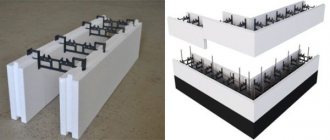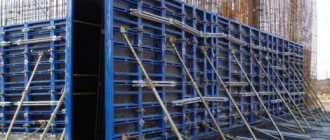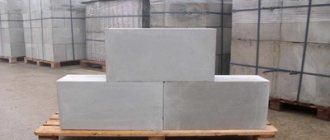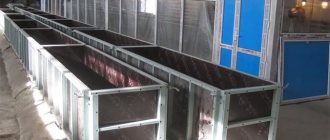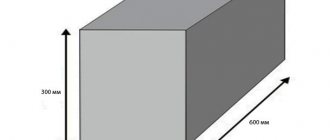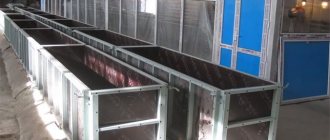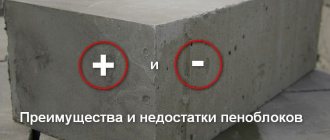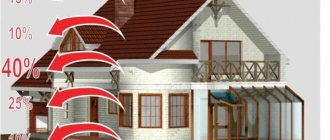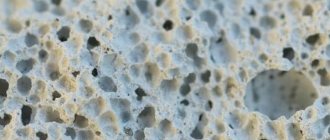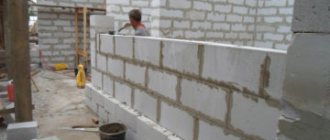When choosing concrete or cement, buyers focus primarily on the brand or strength class.
The grade strength provided for by GOSTs implies division into grades (m-200, m-300, etc.), thus indicating the compressive strength in kgf/sq. cm.
Strength classes (b-15, b-22.5, etc.) mean almost the same thing, but with minor nuances. For more detailed information on the classification of concrete, see the section classes and grades of concrete.
For foam concrete blocks, only one of these parameters is important - the strength class. Despite the most important importance of the strength class of the wall material, on which the integrity and durability of the entire structure being built depends, manufacturers and buyers of foam concrete blocks most often mention another parameter - the density of the foam block. The density of foam concrete is designated letter D with a digital density value in kg per cubic meter. m. That is, the density of foam concrete D600 indicates that a cubic meter of such foam concrete weighs 600 kilograms (subject to a certain humidity). It would seem, what difference does it make how many kilograms a cube of foam concrete weighs?
Well, it weighs 600 and that’s good, 800 weighs not bad either. This is not a foundation block of concrete, which with a similar size would weigh two and a half tons. For the load on the foundation and floor, the density of foam concrete is not critical. Foam concrete, like all lightweight concrete, is valued mainly not for its lightweight qualities. Its main task is to ensure minimal thermal conductivity (maximum thermal insulation) of walls, while maintaining the necessary strength of the entire wall structure.
This is where the main compromise between strength and thermal insulation lies. As an example, we present a table that compares all the main characteristics of foam blocks. The main purpose of the foam block Density of the foam block Strength class VA Similar grade of concrete Thermal conductivity coefficient Frost resistance coefficient FT Thermal insulation contour of the walls D400B0.75M-100.09-0.10 D500B1M-150.10-0.12 Load-bearing and thermal insulation foam block D600B2 ,5M-350.13-0.14F15-F35D700B3.5M-450.15-0.18F15-F50D800B5M-600.18-0.21F15-F75D1000B7.5M-1000.23-0.29F15-F50 Load-bearing walls D1100B10M-150 0, 26-0.34 D1200B12.5M-1500.29-0.38 As you can see, as the density of the foam block increases, its strength and thermal conductivity increases. And if there is no such thing as excessive strength, then in the case of thermal conductivity everything is different.
A higher coefficient of thermal conductivity indicates that the material retains heat less well and also poorly resists the cold acting on the walls of your house from the street. When the density of foam concrete decreases, the thermal insulation characteristics improve, but the load-bearing capacity of the walls made of foam blocks also decreases proportionally. The warmer the foam block, the less load it can withstand. It is interesting to compare the strength of foam blocks with the strength of classic building concrete. As you can see in the table, the grade strength of a standard foam block with a density of D600 is only M-35 (class B2.5), which is almost ten times less than the grade of concrete that was used to pour your foundation (for example, the same concrete M350).
How to choose the desired density of foam blocks (foam concrete)
As we have already found out, the density of a foam concrete block is directly related to its thermal insulation characteristics and load-bearing capacity. The warmer, the weaker, the stronger, the colder. So we need to look for a compromise.
In general there are not many options.
In most cases, builders use foam blocks with a density of D600-D700 as an independent (structural and thermal insulation) wall material. Such blocks are capable of withstanding the load from monolithic floors without installing an armored belt, or ready-made floor slabs (but with the obligatory installation of an armored belt around the perimeter of the slabs). Of course, all types of wooden floors are also applicable in houses made of foam blocks of this density.
As an alternative solution, builders are creating multi-layer structures. Where low-density foam blocks are used only as a thermal insulation material, and the role of load-bearing elements goes to brick, sand concrete blocks or monolithic concrete.
It is advisable to make all combined structures using foam blocks in the form of shell contours.
That is, if there is a wall made of brick, then it needs to be completely lined with foam concrete blocks, and not done in pieces or some separate elements. Several years ago, builders who did not particularly trust foam concrete used mixed structures, when the corner elements of the building were laid out from sand concrete blocks, and the gap between them was filled with vertical “pillars-corners” made from sand concrete blocks. An armored belt was cast along the perimeter (a monolithic concrete strip that distributes the load from the floor slabs onto the walls made of foam blocks) and ready-made floor slabs were installed.
An undoubted disadvantage of this solution is the presence of cold corners and walls in the form of concrete pillars-corners and armored belts. Modern builders are unlikely to use such structures, but it happened, and many still suffer from what happened.
Especially in cold winter, when frost and mold appear inside the house, on the corners and under the ceiling. I hope that I have helped you a little to understand the brands, densities, thermal conductivity and other important characteristics of the materials you buy. For all unclear foam concrete questions, write to With warm and durable frost-free greetings, Eduard Minaev.
The expert measured the speed of propagation of ultrasound in foam concrete structures to determine the average compressive strength, class and grade of foam concrete (see Appendix No. 1, photo).
The measurements were carried out with an ultrasonic tester UK1401, according to GOST 17624-87 “Concrete.
Ultrasonic method for determining strength." The number and location of controlled sections on structures are established taking into account the requirements of GOST 18105-86 “Concrete. Rules for strength control."
Based on the measurements performed, the average strength of concrete was calculated, and the grade and class of foam concrete compressive strength were determined.
The results are listed in Table No. 1.
Table No. 1
No. of measurement site Velocity of propagation of ultrasound in the areas Closest class of foam concrete in terms of compressive strength Brand of foam concrete in terms of average density 1.11800 m/sB 2.5D 6001.21830 m/sB 2.5D 600 1.31790 m/sB 2.5D 600 2.11830 m/sB 2.5D 60 0 2.21820 m/sV 2.5D 600 2.31860 m/sV 2.5D 600
Determination of concrete class
The identified indicators of the strength characteristics of foam concrete are:
- the closest class of foam concrete in terms of compressive strength is B 2.5; grade of foam concrete in terms of average density is D 600.
These indicators indicate that foam concrete is not intended for the construction of load-bearing walls, and is of a thermal insulation nature.
Assessment of work on the construction of a residential building
Examination of the flooding of the apartment - When, in what period (July - September 2008) did the flooding of the apartment occur? Determine the market value of the damage, restoration of the apartment from the flood, at the time of the flood and at the date of the examination? Kitchen examination - When checking the tile floor using a level, deviations from the plane of up to 5 mm by 2 meters were revealed. The seams between the plates are not worn.
When tapping the floor tiles, changes in the nature of the sound were detected. Voids were identified between the elements of the plinth. Examination of a residential apartment - Examination of the apartment for compliance with SNiP and GOST, as well as measurement of the area of the apartment with an explication of the premises. Examination of the structure of the walls of the building - Load-bearing structures (external walls) of the building are made of ceramic bricks with a thickness of 1, with a cladding thickness of ? made of sand-lime brick.
- Date: 04/02/2015 Comments: Rating: 49
Density of foam concrete: does this parameter affect construction? Why know him?
Due to their reliability, lightness, strength and environmental friendliness, foam concrete blocks are considered the most popular building material today.
Due to its properties, foam concrete is one of the most popular building materials today.
All its characteristics are based on the density value, namely its lightness and workability. Working with such blocks, you can immediately see how easy it is to construct buildings from them, and they also contribute to good thermal insulation. And this, in turn, helps you not to worry about additional protection of the walls.
What determines the density of foam blocks? This characteristic is influenced by two factors: porosity and the amount of light filler.
Sand and fly ash are usually used as the latter. Since they have their own density, depending on the proportions in the solution, this also gives the density of the material itself. Another important component is the foaming agent.
Simple calculations
Depending on the purpose, products may have different densities, which are indicated by numbers with a Latin letter at the beginning (For example, D600). Based on this indicator, one cubic meter of product will have a mass of approximately 600 kg.
Thus, determining the weight of one foam block is not difficult.
Main dimensions of individual elements.
- Product dimensions are converted to meters. For example, we use foam blocks and cinder blocks of standard sizes - 200x400x600 mm (D600). It turns out: 0.2 × 0.4 × 0.6 m.
- Next, the volume of one unit of production is determined. To do this, the usual multiplication of all quantities is performed. Yield: 0.048 cu. m.
- The resulting number acts as a divisor for one cubic meter. In this regard, the example looks like this: 1:0.048≈20.83 pcs.
- To find out how much a foam block weighs, you need to divide the total mass of the cube by the number of units. So, it turns out: 600:20.83≈28.8 kg.
Addition! However, the above calculations do not take into account the sorption humidity of the product, which, according to GOST, can range from 8 to 15 percent. Therefore, the actual mass will be slightly larger.
Why is the density of foam concrete so important: main characteristics
Foam concrete production diagram.
This material indicator largely affects the mass, strength and thermal insulation properties of the foam block.
As for weight, the higher the density, the heavier 1 cube of material will be. In the brand name it is designated by the letter D.
The strength of the products will also depend on the density. This is due to the fact that the structure of such blocks contains voids that are formed during the mixing of the solution.
The foaming agent and cement react, resulting in the release of gas. This, in turn, creates mass heterogeneity, and this already negatively affects the strength characteristics. For example, if we take the D400 and D1200 brands for comparison, then the former have a strength of 8-15 kg/cm², while the latter have a strength of 70-100 kg/cm².
In foam concrete, the density also affects the thermal conductivity of the material. This property characterizes how well a material can retain heat in a room. If this indicator is higher, then it will be colder to be in such a building.
Classification of foam concrete.
It should also be noted that the moisture absorption of the material is in many ways directly proportional to the density index. If you use foam concrete with less compaction in construction, then this characteristic will have an indicator of 5, and if with greater density, then 0.5. As much as the material is tolerant of moisture, it is also resistant to frost, because water particles at sub-zero temperatures crystallize and solidify inside the blocks.
Accordingly, the latter cool quickly. In addition, this parameter indicates how many freezing and thawing cycles the foam concrete can withstand. The higher this indicator, the longer the building will stand.
We should not forget that such material was created for average climatic conditions. Therefore, if it is used under other conditions, the technical characteristics of foam concrete may change somewhat.
But there are also contradictory points regarding this material.
Experienced developers know that when working with cellular building materials, their strength, that is, their class, should be taken into account. To do this, they focus on three parameters: tension, compression and shear. In this case, foam concrete specifically refers to compression.
Characteristics of foam concrete blocks.
The presence of air bubbles in the structure helps to reduce heat loss to a minimum, which means that such a structure does not need additional insulation. Foam concrete is marked with a number that indicates the weight of 1 m³. But this is where stumbling blocks arise.
The material is popular because it has a low mass (it makes it possible to carry out work at different heights, while the foundation of the building does not require solidity; a lightweight version can be used) and low thermal conductivity. But if you use high-density foam concrete, it will have fewer voids, which affect the first two characteristics. And this is a problem for many builders.
Therefore, when looking for the required density of a foam block, you should remember that strength and lightness in this material are contradictory things. Therefore, a compromise solution needs to be found.
Return to contents
There are several points that will help resolve this issue.
The optimal grade of building material is D with an indicator of 600-700 kg/m³.
This option is well suited for the construction of reinforced concrete slabs, which are used in interfloor ceilings. In this case, you don’t even have to worry about arranging a reinforcing belt. This look goes well with wood.
But the thickness of such blocks allows working with buildings of only 2 floors and no more. Otherwise, you should carefully calculate the dimensions of all supporting structures in the building. It’s even better if professionals take care of this issue.
Foam concrete blocks are often used as additional insulation.
But then it is necessary to build multi-layer buildings, and for this the design and construction technology itself are somewhat different. Indeed, in this case such a stone will not be the basis, but an auxiliary element. You can use foam concrete with a lower density, which will save money.
However, such material should not be used selectively, but in all areas.
If it is used for cladding, then the entire perimeter of the room must be finished with it. If you neglect this recommendation, then cold bridges appear, then the entire warm effect is canceled. In addition, in such places during the cold season, condensation and frost will form, which will have a detrimental effect on the entire structure.
Return to contents
Connection diagram of foam concrete blocks.
Even by purchasing material with optimal density, the strength can be slightly increased. To do this, you can use several methods that are also applicable when making foam concrete with your own hands:
- The finished blocks are placed in an environment with a high concentration of carbon dioxide and left there for some time. Once the block is ready, the entire process of its ripening must take place in conditions of isolation from moisture. That is, it would be good to protect such a block with moisture-proof material. It is best if such material is steamed. If foam concrete is made independently, then special additives can be added while mixing the solution.
As for preparing the mixture yourself, you should know that the strength of such blocks will depend on the technical characteristics of the components of the mixture, especially the brand of cement. Therefore, when selecting binding components, various fillers and additives, it is necessary to take this point into account.
An incorrect ratio can cause an undesirable chemical reaction, as a result of which excessive gas formation will affect the density of concrete for the worse. After all, too many voids are formed in the mixture, which will lead to a deterioration in the quality of the material.
As for the binder, it is very important to pay attention to the date of manufacture, because after 3-4 months, 40% of the quality disappears.
There is another positive aspect in construction using foam concrete. Over time, the strength of such a material gradually increases, so this nuance should be taken into account when making calculations.
Return to contents
Diagram of a metal cassette mold for foam concrete.
As mentioned above, foam concrete is used both as an auxiliary building material and as a main one. It all depends on its density.
Marking with the letter D and the number following it indicate this characteristic. The lower it is, the lower the scope of its application in terms of responsibility.
Foam concrete marked from D300 to D500 is applicable only as insulation.
Low strength does not allow it to be used for load-bearing elements. It has a strength class of B0.5-B1. Foam concrete marked from D500 to D900 is already a structural and thermal insulation material. One-story buildings are most often built from it.
It has a strength class of B1-B5. Foam concrete marked from D1000 to D1200 is a structural material. Used for the construction of load-bearing structures of several floors. Has a strength class of B5-B12.5.
During construction, it is also important what fastening compounds are used. For foam concrete, you should definitely use a special glue, since it has the same density as the material itself.
If you use ordinary cement mortar, cold bridges will form at the joints. And this leads to a decrease in the thermal insulation of the building. It is also recommended to lay the blocks in 2 rows to avoid such a situation.
When purchasing finished material, you should pay attention to the integrity of the block, whether there are any defects in it in the form of cracks or chips.
Pieces should not easily separate from the surface, much less crumble. High-quality foam concrete has a color ranging from light to dark gray. Upon closer examination, you should pay attention to the bubbles: are they separated from each other or do they merge and whether they are round in shape.
If they are combined, then it is no longer foam concrete, but a gas silicate block. It is very important that the structure is uniform. Otherwise, this will indicate a violation of production technology.
When engaged in construction, you can combine different brands. The main thing is to use each for its intended purpose, otherwise the strength of the building will be very doubtful.
Private houses are increasingly being built from foam concrete. Since the material is relatively new, there are many questions.
The first thing you need to understand is how foam blocks differ from gas blocks. Next, you need to figure out what the dimensions of the foam block are, what their density and weight are. Let's talk about all this further.
Requirements
Each type of building requires different types of foam blocks with different densities. For example, blocks with an index of more than d600-1000 are suitable for the construction of load-bearing and external walls , and less are used only for partitions or the thermal insulation contour of a building.
For load-bearing external and internal
For load-bearing and external walls, the most common types are:
- D-600;
- D-900;
- D-1100.
They are not made in an autoclave and are considered optimal for construction.
For the northern part of the Russian Federation, the optimal wall thickness will be 40 cm, so for the outer wall it is better to take a block measuring 600x300x400 mm with a density of 600 kg. With these dimensions you can build a house up to 3 floors.
D-900 and D-1100 will provide good sound and heat insulation.
For non-load-bearing partitions
For partitions, a foam concrete block with an indicator of D100 - D500 is used . Basically, the size of the blocks is 100x300x600 mm.
A material with this indicator cannot be used in the construction of external walls, as it is not strong enough and the building may collapse. These blocks are also used to insulate the outline of the house.
Foam concrete and aerated concrete - do not confuse
There are two porous building materials of artificial origin on the market - aerated concrete and foam concrete. Their composition is similar.
This is a mixture of cement and sand with the addition of water and a foaming agent. As a result, the mixture acquires a porous structure, which increases thermal conductivity and reduces weight. These are the main advantages of materials of this type.
But not everyone understands the difference between foam concrete and aerated concrete.
This is not surprising: they are very similar in appearance, they even have the same GOST. The difference is mainly in the features of the technology. The characteristics of both materials are very similar and they belong to the same group - cellular concrete.
Foam blocks and gas blocks are visually not too different
What does the density value depend on?
This characteristic is mainly influenced by two parameters: the degree of porosity and the volume concentration of the filler. The role of the latter is played by sand, as well as fly ash. Fly ash is a finely dispersed material consisting of small particles. Sand is denser than ash, therefore, the greater its share in the solution, the higher the average density of foam concrete will be.
The presence of another component, a foaming agent, also plays an important role. Porosity directly depends on the amount of foaming agent in the mixture. Density, on the contrary, is inversely proportional. So, for example, to obtain concrete grade D400, you need to add 0.85 kg of this substance per 1 cubic meter of solution. Material with D1200 contains only 0.45 kg of foaming agent.
What is the difference
The difference between foam and aerated concrete is the foaming agent used and the order of its addition.
When making aerated concrete, aluminum powder is added to the dry mixture of cement and sand, and everything is thoroughly mixed. Then water is added.
As a result of the reaction (aluminum powder with cement components) hydrogen and aluminum oxides are formed. Hydrogen “carbonates” the mixture, resulting in the formation of cells of different sizes - there are large ones - 3 mm or more, and small ones - 1 mm or less. At a low level of production, a non-uniform structure of the block in height is possible.
Such heterogeneity is reflected in thermal conductivity and sound insulation characteristics. Aerated concrete of normal quality has a more or less uniform structure and stable characteristics. So when choosing this material, the level of production is of great importance. Technology for the production of aerated concrete A chemical or organic foaming agent is added to foam concrete in the form of finished foam.
First, the dry components are mixed, water is added to them, foam is introduced into the evenly mixed solution, which gives pores of approximately the same size. That is, foam blocks are more homogeneous in structure (pictured on the left). In addition, the bubble shell is thicker and stronger. Foam block production technology
If we consider materials from this side, then foam blocks have more advantages. But there are other nuances that also need to be taken into account.
Production Features
When choosing building materials, especially such as cellular concrete, you need to pay attention to even the smallest details. Because they are the ones who ultimately influence how warm and durable the structure will be. We will describe these subtleties in this section.
Production technology. The production of foam concrete is so simple that it can be done in the garage. It is enough to buy a foaming agent, and the remaining components are easily available.
The mixture (cement+sand+water) is mixed in any container, a foaming additive is added. Next, the composition is poured into molds. The ripening of the blocks occurs under natural conditions - in the air.
That is, you can do without special equipment, quality control is conditional - you need to adhere to known proportions and technology. But you really want to save money... That’s why there are a large number of foam blocks on the market, the qualities of which are far from those of GOST. Foam concrete has a more uniform structure. Aerated concrete is mixed just as easily, but there are two types - autoclaved and non-autoclaved. Non-autoclave also dries in the open air, but does not have the best characteristics.
Autoclaved aerated concrete undergoes a hardening process at elevated pressure and temperature. As a result, the blocks are of increased strength. They cost more, but are also much stronger. Accuracy of geometric dimensions. Aerated concrete blocks are produced in two ways.
According to one technology, the composition is poured into ready-made molds. These blocks have a difference in size of up to 3-5 mm. Using another technology, large-format blocks are formed, which are then cut to specified sizes.
The difference in the size of such material is minimal. Strength of foam concrete of different densities Foam concrete is poured into ready-made forms. There is no other technology. Accordingly, the difference in block geometry can be significant.
It is corrected by increasing the masonry seam, which reduces the thermal insulation characteristics of the masonry as a whole. So when choosing, focus on geometry. If the blocks are almost identical (GOST allows deviations of 1 mm), there is hope that the technology was followed.
If we consider these materials from this point of view, then autoclaved aerated concrete with minimal differences in dimensions is more preferable.
Masonry from this material is made using special glue. It is applied in a layer of a couple of millimeters, since the ideal geometry allows this to be done. Since the seam on a wall made of this material is a bridge of cold, the wall turns out to be very warm (due to the small thickness of the seam, heat is better retained in the building).
When using foam blocks with a large discrepancy in size, a regular mortar is used for masonry. The glue is too expensive to apply in large layers. When using cement mortar, the costs are much lower, but the thermal insulation characteristics of the building cannot be compared - they are much lower.
Density and mass of foam blocks
Foam concrete can have different densities.
It is designated by the Latin letter D, followed by numbers from 300 to 1200 in increments of 100 units. The higher the density, the greater the mass and strength, but the lower the thermal insulation characteristics. Therefore, according to their area of use, foam blocks are divided into three categories:
from D300 to D500 - thermal insulating blocks made of foam concrete. They are used as insulation (for example, when insulating a balcony or loggia); they are not able to withstand any significant load. Price from one of the companies. Cut blocks are more expensive, but they are much easier to work with. D600 to D900 are structural and thermal insulating blocks.
They are also often called construction ones. They can withstand some loads and have good heat retention properties. These are the ones that are usually used in the construction of private one- or two-story houses.
The optimal choice is D600 and D700. The thickness of the wall when using blocks of this density is only 35-45 cm (for central Russia), and without the need for additional insulation. from D1000 to D1200 - structural blocks.
Capable of bearing significant loads, but thermal conductivity is low. Additional insulation is required. It is rarely used in private construction.
The density of foam blocks affects its mass. In fact, the brand reflects the mass of one cubic meter of material. For example, a cubic meter of D400 foam blocks will weigh about 400 kg, a cube of D700 density blocks has a mass of about 700 kg.
How much a cube of foam blocks weighs depends on the density of the material
Why "about" because the manufacturing process allows for some error. A slightly larger mass is considered normal - within 10-15%.
But at the same time, you need to make sure that there are no foreign inclusions. Some manufacturers add broken brick or crushed stone to reduce costs. Because of this, the mass becomes a little larger, which is generally uncritical.
But these additives greatly reduce thermal conductivity, which is not good at all. And this is no longer foam concrete, but incomprehensible building blocks with unknown characteristics and it is unclear how they will behave during operation. So when buying, be sure to be interested in the mass, and if possible, break a couple and see what is inside.
Area of application of foam concrete
Foam concrete has a wide range of applications, in particular:
- it is used to produce building blocks used for the construction of walls and partitions;
- it is used for monolithic housing construction;
- is a material for heat and sound insulation of walls, slabs, floors, ceilings;
- used as a filler for void spaces, hard-to-reach places, trench cavities;
- for thermal insulation of pipelines;
- They pour it on floors and roofs.
In terms of manufacturability, this material is superior to other structural materials. Foam blocks can be sawed, drilled, milled. In many characteristics they are close to similar parameters of wood, while differing in their durability for the better.
The material is several times superior in thermal insulation compared to brick. As a result, the thickness of the walls of buildings can be made thinner while maintaining the required parameters. In addition, given that the density of foam concrete (kg/cub.m) is lower, the total weight of the box can be significantly reduced when building a house. Thanks to this, it will be possible to reduce the load on the foundation, and it can be made lighter.
A useful article on how to correctly calculate a strip foundation.
